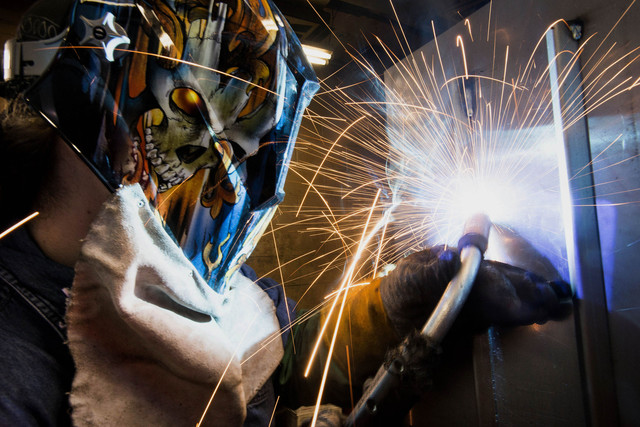Manufacturing in U.S. Expands at a Faster Pace Than Forecast
The Institute for Supply Management’s index rose to 55.7, the strongest since June 2011, from 55.4 a month earlier, the Tempe, Arizona-based group’s report showed today. Readings above 50 indicate growth. The median forecast in a Bloomberg survey of economists was 54.
The Institute for Supply Management’s index rose to 55.7, the strongest since June 2011, from 55.4 a month earlier, the Tempe, Arizona-based group’s report showed today. Readings above 50 indicate growth. The median forecast in a Bloomberg survey of economists was 54.
American producers are leading a global manufacturing recovery that stretches from China to Europe as their economies improve. Resilient U.S. demand for motor vehicles is prompting companies such as Ford Motor Co. (F) to expand, while further strides in construction are bolstering orders for building materials, appliances and furniture.
“It’s going to be a solid quarter for U.S. manufacturing,” said Brian Jones, a senior economist in New York at Societe Generale, who projected a reading of 55.8. “Businesses are expanding production not only to meet demand but to also build inventories. Manufacturing worldwide is impressing to the high side.”
Another report showed construction spending increased in July to the highest level in four years. Outlays climbed 0.6 percent to a $900.8 billion annual rate, the strongest since June 2009, after little change in June, the Commerce Department said.
|
|
Economists’ Estimates
Estimates for the ISM factory index from 85 economists in the Bloomberg survey ranged from 51 to 55.8. Manufacturing accounts for about 12 percent of the economy.
Stocks rose, following the worst month since May 2012 for the Standard & Poor’s 500 Index, as investors weighed the better-than-forecast economic data against possible military action against Syria. The S&P 500 climbed 0.4 percent to 1,639.77 at the close in New York.
Today’s U.S. supply managers’ report follows figures yesterday showing a pickup in other parts of the world. In China, manufacturing strengthened in August, with one gauge posting the biggest jump in three years. Euro-area factory output expanded last month at a faster pace than initially estimated, driven by a resurgence in Italy and Spain as the 17-nation currency bloc’s recovery started to build momentum.
The ISM’s U.S. new orders measure advanced to the highest level since April 2011, while the group’s gauge of export demand rose to a five-month high. The index of orders waiting to be filled also climbed.
Factory Inventories
At the same time, the report showed factory inventories contracted for a second month in August, while customer stockpiles shrank at the fastest pace since November.
“The combination of strong orders growth with weak inventory-building augurs well for future increases in industrial production,” Michael Feroli, chief U.S. economist at JPMorgan Chase & Co. in New York, said in an e-mail to clients.
Automobile purchases, which are on track for the best year since 2007, are helping power gains in manufacturing.
Dearborn, Michigan-based Ford, the second-largest U.S. automaker, is expanding output of its Fusion sedan, and said its factory in Flat Rock, Michigan, could produce another model as demand grows. The additional shift of 1,400 new workers at the plant will boost Fusion capacity more than 30 percent.
“We expect the sales momentum to stay here in the U.S. and around the world,” Joe Hinrichs, Ford’s president of the Americas, told reporters on Aug. 29.
Housing Market
The recovery in housing also is spurring demand for construction materials and encouraging consumers to remodel and spend on appliances, benefiting home-improvement retailers such as Atlanta-based Home Depot Inc. and Lowe’s Cos. (LOW), based in Mooresville, North Carolina. The companies each reported second-quarter profit that topped analysts’ estimates and raised their annual forecast.
The Commerce Department’s construction report showed private homebuilding outlays increased 0.6 percent in July to the highest level since September 2008. The gain included a 0.8 percent advance in home improvement spending. Non-residential projects also picked up.
Construction helped the economy pick up steam in the second quarter. Gross domestic product increased at a more-than-expected 2.5 percent annualized rate after a 1.1 percent gain in the first three months of the year, the latest Commerce Department figures show.



Leave a Reply
Want to join the discussion?Feel free to contribute!